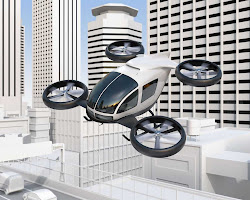The Future of Cross City Transport
SummaryCar travel across cities seems to get worse as populations increase and traffic jams become more prevalent. There are 2 solutions predicted and upcoming first in USA as usual, although China may push through regulations quickly. The proposals are:
Like all new technologies, many problems exist, such as regulations, consumer fear, phobias, etc. The video below shows a Chinese development The FutureWhile rail transport will still be a big factor, most people own a car and this blog relates to the future of road transport. Both robotaxis and eVTOLs hold large potential to transform urban mobility. Robotaxis offer a more immediate solution, reducing congestion and improving safety on existing roads. eVTOLs, while further down the track, promise a leap in urban transportation, offering faster, potentially quieter commutes. The future of city travel is likely a combination of both solutions. Robotaxis may handle shorter trips within cities, while eVTOLs are better for longer distances or congested routes. As technology advances, regulations are settled and public acceptance grows, these solutions could turn the urban commute from a daily struggle into an easy experience. Cities where getting around is not a source of frustration, but a chance to relax, work, or just enjoy the view, whether from the ground or above is a big improvement. RobotaxisAutonomous electric robotaxis have the potential to be 70% cheaper than individual car ownership, because cars are used on average only 52 minutes a day round trip. That’s equivalent to 216 hours, or 27 x 8 hour days, during your year. That time can be spent relaxing, working, reading, etc. This of course does not apply to long country wide trips, but car hire may be the answer for some. TeslaTesla’s plan is to deliver a global fleet of robotaxis. The release of Tesla’s newest version of ‘Full Self Driving’ or FSD 12 is a major departure from Tesla’s previous versions. Unlike prior systems, FSD 12 arose from the technology’s ability to learn autonomously, using billions of video frames to mimic human drivers. With nearly 2 million Tesla cars globally collecting data daily, the company is poised to train and constantly improve FSD 12. WaymoIn August 2023, Waymo in San Francisco, began charging the public for rides in its driverless cars. Rides remain affordable, with fares ranging from $US18 to $US21, much the same as traditional Uber fares. Yet, the potential rewards are huge, with estimates suggesting that the LA market could generate up to $2 billion in revenue for the company. Why This MattersWith the rise of autonomous vehicles, the landscape of the auto industry is poised for a huge shift. Currently home to over a hundred brands, the next decade may witness a substantial consolidation. Two main forces will drive this: car usage rates and functionality. The hidden costs of “free parking,” estimated U.S. expenditures between $US102 billion to $US374 billion may be reduced and unused parked cars become much fewer, freeing up roads, street parking and parking lots. eVTOLS
eVTOLs could eliminate traffic jams. These vehicles offer:
Yet, eVTOLs face their own set of hurdles:
The reality is this transformation will probably take much longer than predicted. Let’s have your views by commenting below. Always interesting! References |


8 Responses
Thank you for the summary. I think the future is exciting and really hope i will be still around to see some of this stuff become every day. When I was a kid I thought the Dick Tracy radio watch would never happen and smart watches are several next gens from that concept.
I recall Jeremy Clarkson (like him or hate him) predicted at least 6 years ago that in the nearish future people wouldn’t own cars and described what we would now call an Uber style robotaxi service. As I recall he didn’t think it was a cataclysmic future. I am sure others like Elon Musk were thinking about it long before Clarkson.
Sci fi films have had similar ideas including VTOLs (propusion source not divulged but usually some magic gravity defying system (using unobtanium perhaps) for many years. eg Bladerunner 1982 and probably other earlier versions that I can’t remember.
David
While some comments are very pessimistic, I agree with yours. Most people underestimate the potential if there is huge advantage, potentially high profitability. Your examples confirm this. I think both are available, sooner with robotaxis as companies like Tesla are way down the track in terms of availability. And no human training is needed as they are self driving.
Hi Campbell,
Just a brief comment as a pilot with more than 40 years’ experience, principally multi-engine fixed wing, but also with more than 40 hours rotary wing, the concept of eVTOL is a long way off.
As someone who understands the peculiarities of aviation, I cannot see this happening for a long time due the need for systems development and extensive pilot training. A general commercial pilot normally trains for at least 12-18 months fulltime for the very basics of flying. If multi engine, night and instrument rated flying is to be included the training the pilots or controllers would need at least 200 hours at a cost that I would estimate to be in excess of AUD$300,00.
Couple all this with noise abatement requirements the whole system would be highly improbable.
The Traffic Collision Avoidance Systems (TCAS) currently used by most airlines to maintain separation (vertical and horizontal) would need considerable refinement. This why current owners of small drones (Remotely Piloted Aircrafts – “RAP”s) have such limitations today i.e. limited to a height ceiling of 400 ft above parks and open areas based on QNH (local barometric pressure). Private aircraft have a minimum ceiling of 1000ft above built-up areas and other height ceilings at various stepped levels in airspaces known as Classes A to G (see https://www.casa.gov.au/search?keys=airspace+classes).
Then there are the issues of radio telephones, aerodynamics, avionics, flight systems and control, astrology, air legislation, weather, etc. etc.
It all seems to work with the “Jetsons” we used to watch.
Overall, unfortunately not in my lifetime or even my grandsons’ lifetimes.
Best regards as always,
Peter
Peter
I appreciate your comments as always, but I don’t believe that driving an eVTOL is as demanding as light or large planes require. See my reply to David. They may go for robodriving as for robotaxis. Drones were introduced quickly and eVTOLs are similar. The bigger concern is I believe is customer phobias
Hope all going well with you.
As usual stimulating. Getting my head around the concept is not easy! Firstly, most people recognise that owning a car is really a matter of convenience I.e to have transport available when you want it. To fulfill this desire I imagine a huge fleet of vehicles available at all times. Where will they be kept? Won’t the roads be choked with the number of cars, remembering 5 people would be the maximum as against buses or trains. Am I missing something? As for aerial transport, this must be a dream. I accept that was said about Jules Verne and Dick Tracey was fantasy, who knows!!
John
I agree the concepts are so life changing, it is difficult to predict timing. But robotaxis are much more imminent that eVTOLs. The difference is the costs savings compared to owning a car which is mainly used in cities for about an hour or so, cluttering up parking spaces when idle. There won’t be any more cars, maybe much less if 4 or 5 people share a robotaxi.
Robotaxis potentially would be on the road continuously so parking is a minor problem. The advantages in freeing up parking lots and street parking are big benefits. Yes cars are convenient but you can call up a Uber in about 3 minutes. With the majority of trips made by huge fleets of robotaxis the wait time should be quicker. I think buses and trains will remain and even now trains are being auto driven. Maybe call the robotrains and robobuses!
I would never travel in any type of aircraft lacking an on board human pilot and do not know anyone who would. The idea of a propeller driven craft in the hands of any Joe Soap the slippery bloke citizen is ludicrous and in my opinion never likely to happen. Think of children (and Joe) around those propellers.
Uber have let me down a number of times and never arrive within three minutes. The cost reliability and convenience of a car trump Uber for most applications. Driverless cars could become popular but they will need somewhere to go to sleep at night (thousands of them).
Kris
Good to hear from you. Taking your comments in order:
1. “Don’t know of anyone who would travel in eVTOL without human pilot.” Like robotaxis, the safety record in time will be much safer without a human pilot. Everyone is fearful of the unknown, but that’s why we have adventurers that sailed and explored the unchartered world and found they didn’t sail over the edge. Now everyone sails in ships and flies in aircraft which like trains in Sydney already are and will be unmanned. Robots are aleady safer than humans. eVTOLs will have sensors that will stop children going near propellors. Anyway they won’t be functional except when everyone is aboard, as with commercial aircraft now. Overcoming people’s phobias will be the major problem and will take time to prove the much higher safety record.
2. I agree Uber can take longer than 3 minutes. There will be far more robotaxis than Ubers increasing nearby availability enormously.
3. I was talking about robotaxi costs, not Ubers.
4. Robotaxis will be on the road continuously except for breakdowns or lack of custom, so parking is not a problem. If people do away with their cars, it will free up a huge amount of idle car spaces that can be used for robotaxis. Cars are used only 52 minutes per day on average in cities. I agree cars may be more convenient but will cost about 70% more. Individual choice. Cars, probably owned only by people in the country, can be hired for long trips. None of this is going to happen overnight. See my reply to John Shand.